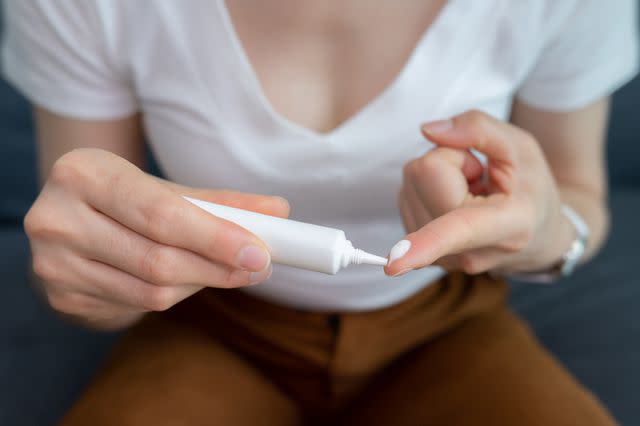Belly Button Yeast Infection: What to Know
Medically reviewed by William Truswell, MD
Yeast infections can crop up in many places, including your belly button. A belly button yeast infection is a fungal infection that affects the skin around your navel.
Belly button yeast infections cause a bright red, itchy rash. The medical name for this infection is Candidiasis. It happens when yeast that usually lives on your skin grows out of control.
This article discusses the symptoms of belly button yeast infection, its causes, and treatment options.

Boy_Anupong / Getty Images
Symptoms of Belly Button Yeast Infection
A belly button yeast infection typically causes a bright red rash on the skin of your navel. It might itch or burn. You may also notice:
Swelling
Pimples
Scaling
Clear discharge around the area
Typically, belly button yeast infections don’t cause a strong odor. However, you may observe a slight musty smell.
How to Know If It Is Fungal or Bacterial
Knowing if a fungus or bacterium causes a skin infection is sometimes challenging. However, these infections are treated differently. It's important to see a healthcare professional who can accurately diagnose you.
What Causes a Belly Button Yeast Infection?
Like the rest of your skin, your belly button naturally has yeast. This isn’t usually a problem. However, if the yeast grows too much, it can cause a yeast infection in the folds of your navel.
Yeast tends to overgrow in warm, moist environments. You may be more likely to develop a belly button yeast infection if you:
Fail to wash your belly button
Wear tight clothing
Don’t change clothing often enough
Get sweaty in hot weather
Have a belly button piercing
Who Is at Risk?
People with certain medical conditions that affect the immune system, such as diabetes and psoriasis, are more likely to develop yeast infections. Pregnant people and overweight individuals are also at risk.
Are Belly Button Yeast Infections Contagious?
Typically, belly button yeast infections aren’t contagious. However, people with weakened immune systems might have an increased risk of contracting a yeast infection if they are around someone with one.
How Is a Belly Button Yeast Infection Diagnosed?
If the skin around your belly button is red and irritated, it’s important to consult with a medical professional to get an accurate diagnosis.
Healthcare providers typically diagnose a belly button yeast infection by asking about your symptoms and looking at your navel. They may scrape off a skin sample to examine under a microscope or place it in a culture. This can help confirm that you have a yeast infection.
What Is Intertrigo?
Intertrigo is a skin condition that happens when the folds of the skin rub together. It commonly leads to a fungal infection, such as a belly button yeast infection.
How Is a Belly Button Yeast Infection Treated?
Your healthcare provider might recommend an antifungal cream, ointment, or powder to treat your belly button yeast infection. Some of these products can be found over the counter (OTC), while others require a prescription. They are applied directly to the skin in and around your navel.
Sometimes, providers will prescribe an oral medication, like Diflucan (fluconazole), to treat a stubborn infection.
What to Expect If You Have a Belly Button Yeast Infection
If you have a yeast infection, you may have red, irritated skin on and around your belly button. Often, these infections will heal on their own if you keep the area dry and clean. However, many people respond well to antifungal medication. Your infection should start to clear up within two weeks of taking the treatment.
Will it Come Back?
Belly button yeast infections often recur, particularly if you don't clean the area. People with weakened immune systems are more likely to experience infections that come back.
Home Remedies and Self-Care Strategies
You may be able to help manage a belly button yeast infection at home with these measures:
Keep the area clean and dry.
Use a warm compress to help with pain or discomfort.
Try an over-the-counter antifungal cream or ointment.
Apply tea tree oil to the skin. One study found it may help kill yeast.
Use a probiotic. Some research shows probiotics may work against yeast.
Apply coconut oil. It’s known to have antifungal properties.
How to Prevent Belly Button Yeast Infections
Keep your navel dry and clean to help prevent a belly button yeast infection. Showering with soap and water should be enough to keep your belly button clean. Don’t apply lotions or creams to your belly button; these products can invite fungal growth.
Losing weight may also aid in slowing the growth of yeast. Additionally, if you have diabetes, keeping blood sugar levels under control can prevent yeast buildup.
Summary
A belly button yeast infection happens when the yeast grows out of control in your navel region. It’s typically red, itchy, and sometimes painful. There are several over-the-counter and prescription treatments that are available as topical and oral medications.
See your healthcare provider if you have symptoms of a belly button yeast infection so you can get proper treatment and care.
Read the original article on Verywell Health.

